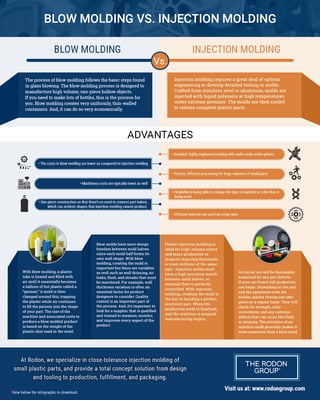One of the first steps in creating a molded plastic product is to decide on a manufacturing technique. Blow molding and injection molding are two popular processes with unique advantages and drawbacks. It's important to develop a good understanding of both methods before you can determine which one is most suitable for your company's needs. This blog post will discuss the difference between a blow mold and an injection mold, and the most common types of products made using each technique.
Blow Molding vs. Injection Molding
While blow molding and injection molding both involve filling molds with melted plastic, their processes and the types of objects they can create are very different. Let's take a look at each method.
What is Blow Molding?
Blow molding creates hollow products from thermoplastic materials. Technicians create performs, or parisons, by heating and expanding plastic tubes. The preform is placed between two dies that contain the final product's desired shape. Next, air is supplied into the tube, causing it to gradually expand and conform to the mold's shape.
After the blowing process is complete, the product is cooled and then ejected from the mold. It is then trimmed of any excess material and prepared for secondary processes.
Blow Molding Advantages
Blow molding allows manufacturers to create high quantities of hollow plastic products in a short period of time. Some of the benefits blow molding delivers include:
- Low machinery costs
- Automated production
- High product variety
- Many production methods, such as extrusion blow molding, stretch blow molding, and others

Blow Molding Products
Blow molding has become a very popular manufacturing process. Many industries use it to create containers or other products. Some of the most common applications for blow molding products are:
- Automotive components
- Appliance parts
- Children's toys
- Industrial bulk containers
- Medical supplies
- Marine products
- Lawn and garden items
- Product packaging
- Sporting goods

10 Must-Ask Questions eBook
What you need to know before selecting a molder for your project
Download our eBook, “10 Must-Ask Questions When Choosing a Plastic Injection Molder.” Inside, we cover key questions like:
- Does the molder guarantee the molds for the life of a project?
- How many molding machines do they have and what are their capabilities?
- Is their pricing competitive, even when comparing with offshore molders?
What is Injection Molding?
Injection molding is the process of creating solid plastic parts using precision molds and tooling. It involves using a machine to inject molten plastic materials into a custom-developed mold to produce a product. Injection molding is an excellent way to economically mass produce custom, solid plastic products.
Injection Molding Advantages
Injection molding is an excellent method for producing high-precision, highly repeatable plastic parts at a minimal cost per unit. Some key advantages of injection molding include:
- Fast and efficient production
- Low labor expenses
- Exceptional design flexibility
- Compatible with a wide range of materials

Injection Molding Products
In applications where a high degree of design intricacy is required or where high-volume production runs are needed, injection molding provides an effective solution. This versatile process creates a wide variety of products, including:
- Agricultural components
- Automotive components
- Electronic housings
- Toys
- Plastic bottles
- Healthcare products
- Construction products
Custom Plastic Injection Molding From The Rodon Group
Blow molding and injection molding are two popular methods for creating plastic parts. At The Rodon Group, we offer custom plastic injection molding solutions developed with quality and efficiency in mind. As an ISO 9001:2015-certified manufacturer, we specialize in high-precision plastic parts that adhere to tight tolerances. If you think injection molding might be a good solution for your next project, get in touch with our team or request a quote today.








Comments